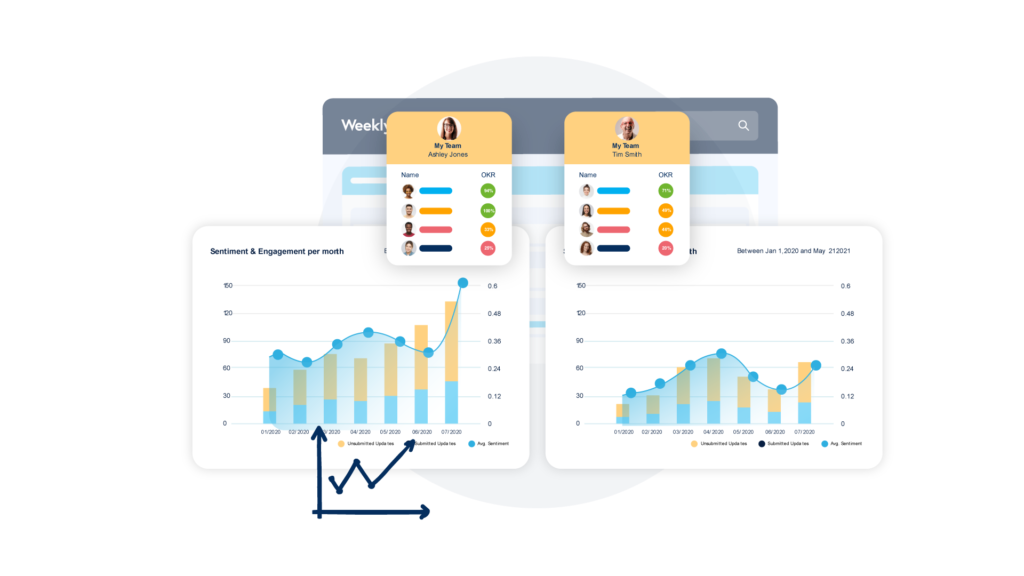If you look after your people, your people look after you, right? Well to truly look out for your team, you’ll need to understand how they are feeling, how they’re performing and how to improve things for them. And that’s where we come in. With AI-powered sentiment analysis, an employee check-in measures employee sentiment, giving you actionable insights to build a better place to work.
Why employee check-ins work to measure employee sentiment
Without sentiment analysis, employee engagement becomes virtually impossible to track in any meaningful way. The HR leaders in our readership don’t need us to tell them what a huge headache that can be.
What you need is relevant data derived from employee insight, or you’ll have to fill in the gaps with guesswork. Don’t make the mistake of assuming you always know what your people want.
Fortunately, checking in with employees is the best (and easiest) way of getting a large volume of sentiment data. Other methods, like traditional engagement surveys, tend to offer a brief snapshot. And, although that can still be useful, it overlooks important context. As you’ll learn through sentiment analysis, employee engagement isn’t a binary switch. It’s a broad spectrum, prone to gradual shifts over time.
What is an employee check-in?
When an employee fills out their weekly check-in, they answer a set of individually personalised questions. These questions should address things like their wellbeing and job satisfaction. They should give employees the chance to raise issues in their own words and give colleagues recognition.
We’ve designed our employee check-in to do one simple thing: make frequent feedback easier and more effective. which leads to better employee engagement and performance. A well-crafted employee check-in forms a vital lifeline in your workplace. It doesn’t just make life easier for managers and HR personnel, but your employees too.
What else makes check-ins useful for measuring employee sentiment?
One point you can’t afford to miss is that they offer a blend of quantitative and qualitative question types. So, for example, you might set a rating scale question asking about job satisfaction. But, if you don’t include an open-ended equivalent, or at least a comments box, you’re missing out on half the value.
Then there’s the regularity, which is essential for building rapport. Employees can be cynical about stuff like this (thanks a lot, annual engagement surveys!). But, if you’re consistent with your check-ins and follow through on what your people tell you, they’ll start to have some faith.
Last year, the Workforce Institute posted some damning findings. 83% of UK employees feel that people aren’t heard fairly or equally in their organisation. On top of that, one in three would rather quit than voice concerns at work. So there’s a blatant need for check-ins to pick up the slack (the expression, not the messaging platform!).
Beyond that, we reckon it’s the small stuff that helps make our check-ins so popular. Accessibility is at the core of our work philosophy. That includes designing our tools so even the least tech savvy among us can get to grips with them.
People even have choices about where they log into their check-in profile. Sure, you could open a browser window. But, if you’re already doing stuff in Microsoft Teams or Slack, why go anywhere? You can use our app extensions to keep all your work in one place.
How sentiment works in Zensai to improve employee engagement
Using sentiment analysis, employee engagement becomes much easier to track. But why is that, exactly?
Sentiment analysis uses AI-driven techniques like NLP (Natural Language Processing). By doing this, sentiment analysis algorithms can “mine” text for emotional tone. To over-simplify a little, it does this by studying the word choices and associations people use to figure out how they feel.
It’s like how a check-in balances qualitative and quantitative questions. By creating a metric for emotional tone, sentiment analysis can turn open-ended responses into hard data. Do this using check-in data from your entire employee base, and suddenly, you have a clear image of where your people stand.
Our algorithm measures employee sentiment alongside your check-in data. And, since those are regular and ongoing, it’s easy to analyse trends in the long-term. So, if something changes, our bespoke sentiment reports will tell you. But that’s not the only benefit of using check-in data.
Slice and dice the data to understand employee engagement across different groups of employees
Since check-ins are individual and quite personal, you have all the info you need to break data down across demographics. Implemented new feedback policies? See how your Gen Z employees react compared to your older employees. Got a new framework for booking maternity leave? It’s worth specifically looking at what the women, non-binary employees, and trans men in your company think.
And, finally, there’s perhaps the most important benefit of real-time feedback and sentiment analysis. It’s easy to match your reports to a timeline of recent events. So, when something happens, you can see how it impacts engagement and morale.
For example, the loss of a major client might rock your entire firm. Or maybe you redesigned the office, only to find engagement is now suffering. But internal developments aren’t the only ones that can shake employee engagement.
The pandemic is the most obvious example. During lockdown, Gallup found that global engagement hit an all-time low of a mere 20%. More recently, the death of Queen Elizabeth II has hit a lot of people in the UK quite hard. It’s a controversial topic. But, regardless of how you feel about royalty, it’s worth noting how this development affects your people. During times of uncertainty, people look to their employers as a sort of rock, or guiding star. But you won’t be able to help if you’re not engaging with how your people feel.

Measure sentiment to easily track employee engagement
10Pulse is our tool for providing an employee engagement metric. We launched it back in 2020, with some of our existing clients taking part in the Beta tests. It was a huge success, and we’ve since rolled 10Pulse out for all of our clients to use. Since then, it’s gone down well with HR directors and managers alike.
Engagement can be difficult to pin down, due to all the contributing factors behind it. But, with sentiment analysis, employee engagement becomes much easier to track. So, with 10Pulse, we’ve parred it down to the five Key Performance Indicators of high engagement:
- Feeling valued by others.
- Pride in your work.
- Enthusiasm as a brand advocate.
- Willingness to offer discretionary effort.
- Overall job satisfaction.
10Pulse draws info from a variety of sources, but sentiment analysis is among the most important. Using these criteria as a base, 10Pulse uses sentiment data to create a proper engagement metric.
But it’s far from just some arbitrary number. Going through your 10Pulse report, you can break the figures down to see how each KPI performs by itself. After all, your people can advocate for the brand and feel proud of their work, yet still feel undervalued by their employer. It’s one thing to look at the big picture, but quite another to scour it with a magnifying glass.
At the risk of stating the obvious, all five engagement criteria are heavily based in emotion. But our 10Pulse sentiment analysis uses NLP and other methods to provide your 10Pulse report with an objective measure.
Perform365 10Pulse gives you the specific areas to focus on to improve employee sentiment
By focusing on these KPIs, you’ll easily see how to go about resolving engagement issues. If people aren’t feeling valued or taking pride in their work, you can aim to provide more recognition.
If they’re not advocating for the business, look at your work culture and business practices. And when people aren’t satisfied by their role or stop going the extra mile, find ways of generating enthusiasm.
Don’t forget that even 10Pulse is simply a means to an end. It’s extremely effective at identifying problems that HR need to tackle. But it’s not going to fix them for you by magic. You have to follow through on the insights you get, or you may as well have done nothing.
And, at the end of the day, you’re not short of options for how to do these things. Support strengths-based management and job-crafting. Provide mentorships and offer secondments. Push for better wages if that’s what it takes. Like the proverbial horse, 10Pulse and sentiment analysis can lead you to water. But it’s up to you to drink.



